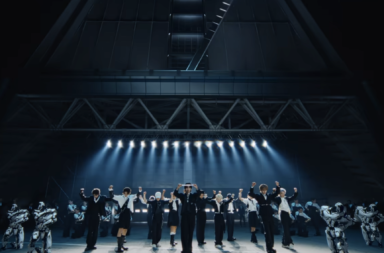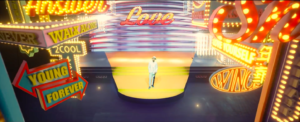
One of the key reasons many people continue the debate around K-pop’s definitions—is it a genre, a field, an industry?—is that it is inherently multi-media. Here, music combines with fashion, marketing, and visuals to an extent that stands out on the world stage. Given that the visual element of K-pop is so woven into its foundations, there are inevitable motifs, symbols, and aesthetics that reappear throughout various concepts and MVs. One of the most popular of these? Cinema, naturally.
The defining art form of the twentieth century, cinema across the globe has long since embedded itself as one of the most universal visual playbooks. From classic Hollywood movies of the 1940s and 50s, with iconography so familiar you don’t need to have seen any of it to know its world, to the dazzling spectacles of Bollywood, the world’s biggest film industry, cinema is baked into cultural narratives the world over. Korea is a great, innovative player itself on this stage; from Oldboy to Parasite, it has its own cinematic iconic pedigree.
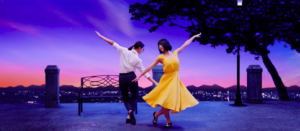
With a great modern encyclopedia of visual reference points and aesthetic choices, cinema is a rich resource K-pop has often mined. It would be easier to list the groups and artists who haven’t included film references of some nature in their work, such is its ubiquity. But what exactly is a ‘reference’? A fleeting scene of idols playing dress-up as some of our favourite on-screen characters? Sometimes, yes. But, alongside this, K-pop often uses cinema in more complex ways to enrich its visuals and storytelling. From echoing the storylines and characters of famous films in their lyrics, all the way to echoing a film’s aesthetic to achieve their own world-building, cinema is so not so much a tool in K-pop, but more an entire toolbox.
When we think of ‘cinema references in MVs’, it is undoubtedly the more recognisable, cosplay-esque mode that we turn to first. A cinema reference means using a scene, or a quote, from a movie in an MV, right? There is certainly no shortage of groups that prove this point. Perhaps the most famous example from recent years is in Twice’s “What Is Love?” a veritable smorgasbord of Hollywood dress-up: Mia and Vince from Pulp Fiction, Romeo and Juliet from the dazzling Baz Luhrmann, and Ghost’s Sam and Molly to name a few.
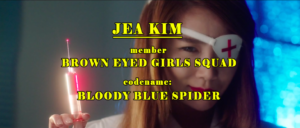
In examples like this, AOA’s “Get Out”, Sunmi and JYP’s “When We Disco” and more, the reason for the cinematic referencing doesn’t cut deep. As we can see in “What Is Love?”, it is literally a source of fun, with the members hanging out and enjoying themselves as they watch their movie clips on screen. Much as spotting a nod to another film in a movie you’re watching is an entertaining little thrill (ah, I know where they got that from), here, the references are a joyful little moment of play. As Sunmi’s “You Can’t Sit With Us” demonstrated (she really does have a claim as K-pop’s cinema queen), there is a high camp potential in pulling out everything from Mean Girls to The Matrix.
But the use of an obvious visual nod to a popular movie is far from just a simple excuse to see idols in some different outfits. The examples above represent a very surface level of cinematic referencing, but many K-pop groups have taken the iconography, narrative, and literal cinematography into their work more deeply and completely. One of the most committed examples of this is Brown Eyed Girls’ “Kill Bill”, with an MV that spreads over seven minutes, the first few an almost shot-for-shot remake of the Tarantino film of the same name.
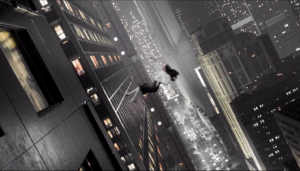
Whilst there is huge entertainment to be had from the level of detail in the video, the decision to use this film for this song is clearly narrative. With lyrics that show a woman talking back to a partner who belittled and humiliated her, the song tells a tale of vengeance. The title and video’s homage to this most recognisable of modern revenge movies is therefore a fitting scenario to best illustrate the nature of this relationship. Brown Eyed Girls are showing us their story and emotion through connecting it to a cinematic one that is so familiar.
Whilst, perhaps sadly, there aren’t more direct film remakes in lengthened-out MVs, this particular use of cinema for narrative is just as common, if not more so, than the cosplay style reference blitz of Twice et al. To return to our screen queen Sunmi, in her own hit “Tail” we see her portraying Catwoman from 1992’s Batman Returns. Though the narrative link isn’t as strong here as with “Kill Bill”, the character choice still reflects the singer’s sense of sensuality and devilishness as she toys with her love interest:
“Stop asking me questions
Wagging my tail for your last words”
Similarly, in Monsta X’s “Love Killa”, the members’ portrayal of different on-screen villains and killers underscores the unbalanced intensity of the lyrics’ “cruel and beautiful” love. Cinema is, in these examples, a character or story-based reference point that helps clarify the narratives of the songs themselves.
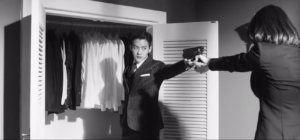
In BTOB’s “Movie”, the very concept of the ‘typical movie romance storyline’ is the reasoning behind the multiple film screen recreations (making it slightly confusing as to why Suicide Squad’s Joker and 8 Mile get a nod). The members want an “obvious” love like those in films, where boy meets girl and they live happily ever after. How better to illustrate this than with classically cinematic scenes, themselves so bold and clear in their messaging? As with Monsta X, there are multiple films included in this MV, (including Pulp Fiction’s famous dance sequence, a contender for the most-referenced film scene in K-pop), illustrating that cinema as iconography and aesthetic is often more influential than the specific narratives of certain films.
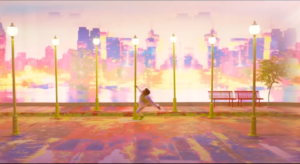
Sometimes this iconography comes through a visual symbol, whether covert or overt, that borrows in order to add to the MV’s storyline. Separate from the above examples, these symbols don’t directly connect to any lyrical element of the song, and so instead serve to layer the MV as a piece of visual art.
BTS has particular form in this area. In “Spring Day” one of the main settings is a train, seemingly during winter time, often taken as an homage to Bong Joon-Ho’s Snowpiercer. The movie, telling a story of the Earth’s last survivors existing on a class-segregated train, does not seem to directly link with any of the lyrics’ yearning for a lover to return. However, the film’s themes of injustice and hope for a better world echo the song’s themes in interesting, complex ways, adding a dimension to the song that we may not have found otherwise. Similarly, in “Boy With Luv” the multiple Singin’ In the Rain set pieces have no lyrical counterpart, but do speak to sense of joy in simplicity that matches the song’s topic.
Often MVs reach further then just one visual cue, and instead utilise an entire film aesthetic to create a world for their work. This is, of course, not unique to K-pop MVs (we see you “Thank U, Next”), and also not at all unexpected. When the word used for the style of filming something is called ‘cinematography’, film evocations will never be far away.
In this field it is naturally the more visually distinctive filmic styles that we see the most. This is a common technique with examples being the woozy, deeply colour-saturated shots of Wong Kar-Wai in Suzy’s “Yes No Maybe” and Mamamoo’s “Wind Flower”, primary colours and symmetrical, square perspectives from Wes Anderson in EXID’s “Lie”, and fromis_9’s “Talk & Talk”, dark backdrops lit with bold neon lighting amid towering skyscrapers à la Blade Runner in Cravity’s “Gas Pedal”.
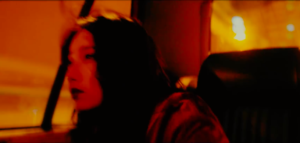
Evoking these aesthetics as settings for MVs can serve a clear purpose of linking the themes of the song to the film/film style it chooses to represent. To take Wong Kar-Wai as an example, utilising his distinct style also allows artists to ruminate on concepts like the flow of time, feelings of isolation, and the nature of romantic relationships. This comes through in the uncertainty of Suzy’s “Yes No Maybe”, whilst “Wind Flower” becomes one of Mamamoo’s most thoughtful songs through these cinematic choices.
But beyond this use of a certain film style to mirror that style’s themes, the use of a cinematic aesthetic in an MV can move even further still. In the most accomplished cases, the use of a film aesthetic serves to build a cohesive world that enhances every level of a song, and even a discography of a group. This world-building obviously has different levels of efficacy depending on how committed and well-crafted it is; Cravity’s “Gas Pedal” and earlier “My Turn” fail to turn their Tron/Blade Runner/Ghost in the Shell neon cyberpunk world into a coherent backdrop that adds to their overall outlook.
But for other groups, such as TXT, this technique works well. In their 2019 “Nap of a star”, their MV makes a magical fairy tale world out of the aesthetic of silent cinema, particularly Georges Méliès La Voyage dans la Lune. Complete with chapter title cards, subtitles explaining the storyline, and stop-motion style visuals, this MV creates a stripped-back feel which makes the core story feel all the more elemental. Using the cinematography of silent cinema allows the MV to tell its sweet, folk-esque tale in the most fitting way possible, whilst also building onto the universe TXT has created across their work. This is an MV that is not so much referencing cinema, as becoming it.
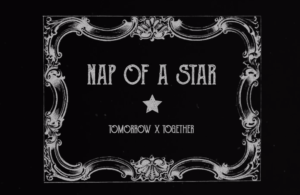
This point that TXT manages to reach is the apex of what is possible when using film in MVs. Through the creation of entire worlds through the lens of recognisable film motifs, aesthetics, and settings, the best of these videos become cinematic in their own right, demonstrating the potential K-pop has—with its inherent multi-media nature—to operate as an art form.
Through the use of symbols, costuming, editing, cinematography, and beyond, K-pop MVs become their own cinematic experiences. Much as the most critically lauded songs will be given the title of “art” rather than pop (an unfair distinction, but one often made all the same), using cinema in MVs becomes a toolkit that groups can use to elevate their own work to this status. With the Hallyu Wave sweeping over the film world as it is, cinema is also soaked into the fabric of K-pop. The more we see it utilised–in everything from cosplay to world-building–the more chances of higher level art we will get from K-pop idols.
Images via HYBE Labels, JYP Entertainment, Nega Network, ABYSS COMPANY & Cube. Lyrics via Genius.
